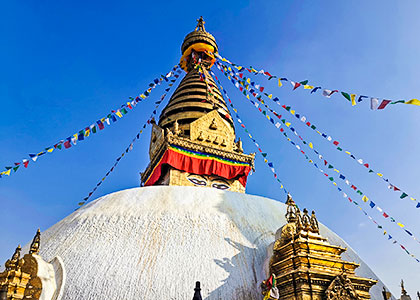India & Nepal Highlights
TSA01: 10 Days Private Tour of Delhi - Jaipur - Agra - Kathmandu
Tour Type: Private tailor-made tour, experienced guide and driver
Accommodation: 4-star handpicked hotels, also be open to your own choice
Highlights:
Accommodation: 4-star handpicked hotels, also be open to your own choice
Highlights:
- The quintessential Golden Triangle of India and the capital of Nepal.
- Two ancient civilizations with intensive World Heritage – a total of 9 sites!
- Immerse in a genuine vacation setting in the Pink City of Jaipur.
- Watch sunrise from the Taj Mahal, a place that best describes India.
From USD1779USD1601Free Inquiry
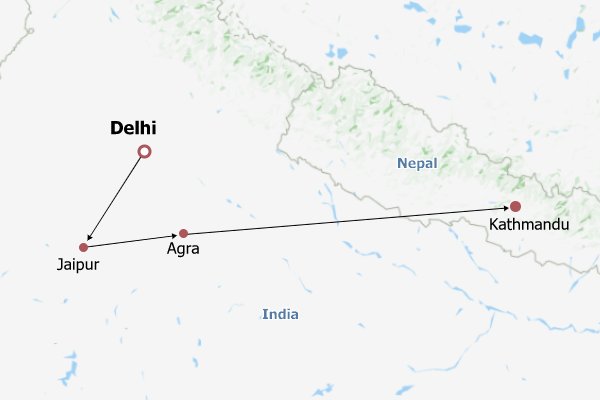
- Itinerary
- Prices
- Reviews
Expand All
Collapse All
Day 1 Arrive in Delhi, Airport Pick-up
Welcome to join this 10 Days India and Nepal tour! Upon your arrival at the Delhi Airport, our local representative will meet you and then transfer you to our well-prepared hotel in private car. The rest of the day is free for you to recover from jet lag or explore the city as you like.
Differences between India and Nepal
1. Religious. India is a polytheistic country, with the majority being Hindus, followed by various religious beliefs such as Islam, Christianity, and Sikhism. While Nepalese people mainly believe in Hinduism and Buddhism, and important religious sites such as the highest Buddhist temple and the largest Hindu temple in the world are located in Nepal.
2. Language. Hindi is the most widely used language in India, but according to statistics, there are over 1600 languages spoken in India. Many higher-caste Indians can speak English.
The official language of Nepal is Nepali. The pronunciation, vocabulary, and grammar of Nepali are different from Hindi. In addition, Nepal also has several other local languages, such as Madi and Ruhia.
3. Food. Indian cuisine is renowned for its diversity and rich flavors. The commonly used seasonings in Indian cuisine include ginger, garlic, chili, cumin, and various spices such as curry powder and turmeric powder. Indians enjoy spicy food and have it with rice, noodles, and various vegetables. Nepalese cuisine is simpler and lighter, using less chili and spices. Rice, vegetables, and buttered tea are the main foods.
4. Clothing. Indian women often wear formal dresses made of brocade in bright colors. Nepalese people, on the other hand, pay more attention to comfort and simplicity, they often wear traditional clothing during traditional festivals and ceremonies.
Is It Safe for A Single Woman to Travel in India and Nepal?
The answer is absolutely yes, because we have a professional team, and our tour guides and drivers in both countries are professionally trained and very responsible. But it is intelligible that people have such concerns, as there have been reports of Indian men showing disrespect towards women or engaging in sexual harassment. However, some locals are hectic but most of them are very enthusiastic and friendly. Nepalese are somewhat simple and kind. In a word, our guide and the driver will escort you during the vacation and we will offer a safe and gorgeous holiday for you.
Accommodation: Crowne Plaza New Delhi Rohini



Differences between India and Nepal
1. Religious. India is a polytheistic country, with the majority being Hindus, followed by various religious beliefs such as Islam, Christianity, and Sikhism. While Nepalese people mainly believe in Hinduism and Buddhism, and important religious sites such as the highest Buddhist temple and the largest Hindu temple in the world are located in Nepal.
2. Language. Hindi is the most widely used language in India, but according to statistics, there are over 1600 languages spoken in India. Many higher-caste Indians can speak English.
The official language of Nepal is Nepali. The pronunciation, vocabulary, and grammar of Nepali are different from Hindi. In addition, Nepal also has several other local languages, such as Madi and Ruhia.
3. Food. Indian cuisine is renowned for its diversity and rich flavors. The commonly used seasonings in Indian cuisine include ginger, garlic, chili, cumin, and various spices such as curry powder and turmeric powder. Indians enjoy spicy food and have it with rice, noodles, and various vegetables. Nepalese cuisine is simpler and lighter, using less chili and spices. Rice, vegetables, and buttered tea are the main foods.
4. Clothing. Indian women often wear formal dresses made of brocade in bright colors. Nepalese people, on the other hand, pay more attention to comfort and simplicity, they often wear traditional clothing during traditional festivals and ceremonies.
Is It Safe for A Single Woman to Travel in India and Nepal?
The answer is absolutely yes, because we have a professional team, and our tour guides and drivers in both countries are professionally trained and very responsible. But it is intelligible that people have such concerns, as there have been reports of Indian men showing disrespect towards women or engaging in sexual harassment. However, some locals are hectic but most of them are very enthusiastic and friendly. Nepalese are somewhat simple and kind. In a word, our guide and the driver will escort you during the vacation and we will offer a safe and gorgeous holiday for you.
Accommodation: Crowne Plaza New Delhi Rohini
Day 2 India’s Essence in Capital Delhi
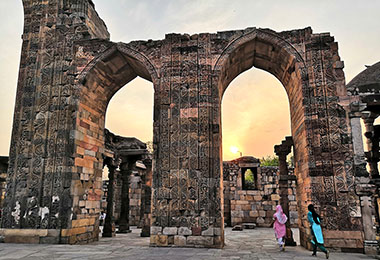
Qutub Minar
After breakfast, our guide will first lead you to visit the Raj Ghat, the mausoleum of Mahatma Gandhi, the Father of India. Built with black marbles, it is unadorned and extremely simple. Then we will drive by the Red Fort, the largest palace in India. This red sandstone octangle building is constructed in typical Mughal Empire architectural style. Afterwards, the guide will take you to the Jama Masjid, one of the three largest mosques in the world, where you can feel the solemn religious atmosphere.
★ Special Experience: Rickshaw Ride
We will arrange for you to take a rickshaw through the lively Chandni Chowk area, full of noisy shops, street food and hawkers. Here you can experience the local people's life.
In the afternoon, we will continue our trip to the tallest brick minaret in the world, the Qutub Minar. It was made of red sandstone and marble around 1,000 years ago. Next, we will move on to the Humayun’s Tomb, which looks like a beautiful garden and is said to have inspired the design of the Taj Mahal. Later, the guide will accompany you to visit the 42-meter-high India Gate built in memory of the Indian soldiers who died in the World War I. Finally, we will end the day at the Gurudwara Bangla Sahib, one of the most famous pilgrimage sites for Sikhs, which is more than 200 years old.
Meals: Breakfast
Accommodation: Crowne Plaza New Delhi Rohini



★ Special Experience: Rickshaw Ride
We will arrange for you to take a rickshaw through the lively Chandni Chowk area, full of noisy shops, street food and hawkers. Here you can experience the local people's life.
In the afternoon, we will continue our trip to the tallest brick minaret in the world, the Qutub Minar. It was made of red sandstone and marble around 1,000 years ago. Next, we will move on to the Humayun’s Tomb, which looks like a beautiful garden and is said to have inspired the design of the Taj Mahal. Later, the guide will accompany you to visit the 42-meter-high India Gate built in memory of the Indian soldiers who died in the World War I. Finally, we will end the day at the Gurudwara Bangla Sahib, one of the most famous pilgrimage sites for Sikhs, which is more than 200 years old.
Meals: Breakfast
Accommodation: Crowne Plaza New Delhi Rohini
Day 3 Road Transfer from Delhi to Jaipur
Today, we will start a road trip to Jaipur by our private car, our driver will be in service. The 283 km (176 mi) road takes 5 to 6 hours. On the way, our driver will stop along the way for you to enjoy fresh air, to stretch and for toilet. If interest, you can buy a cup of coffee and take short breaks. Upon arrival in Jaipur, check into the hotel and have a good rest.
Free Time Suggestion
Prince Albert Edward of Wales, known as the future Edward VII, visited India for eight months in 1876, with Jaipur being one of the stops. In preparation for the Crown Prince's visit, the government not only painted the buildings pink, built this classical building, and initially named Albert Hall. It was not until 1880 that it was established as Albert Hall Museum showcasing folk arts and crafts. The main exhibition hall has two floors, showcasing weapons, porcelain, stone carvings, lacquerware, silverware, textiles, as well as various rare treasures collected from around the world. The treasure of this museum is a female mummy from ancient Egypt that dates back 3000 years. There are a large number of pigeons at the entrance of the museum, which are very photogenic.
If you are not interested in visiting museum, then strolling along the local market may be a good choice. One is Heritage Textiles. The traditional handmade textiles here are the most popular, such as customized clothing, cashmere shawls, household items, etc. The professional tailors can customize your clothing with different fabrics. The other is Bapu Bazar, you may find various small commodities and accessories needed in daily life here.
Meals: Breakfast
Accommodation: Holiday Inn Jaipur City Centre



Free Time Suggestion
Prince Albert Edward of Wales, known as the future Edward VII, visited India for eight months in 1876, with Jaipur being one of the stops. In preparation for the Crown Prince's visit, the government not only painted the buildings pink, built this classical building, and initially named Albert Hall. It was not until 1880 that it was established as Albert Hall Museum showcasing folk arts and crafts. The main exhibition hall has two floors, showcasing weapons, porcelain, stone carvings, lacquerware, silverware, textiles, as well as various rare treasures collected from around the world. The treasure of this museum is a female mummy from ancient Egypt that dates back 3000 years. There are a large number of pigeons at the entrance of the museum, which are very photogenic.
If you are not interested in visiting museum, then strolling along the local market may be a good choice. One is Heritage Textiles. The traditional handmade textiles here are the most popular, such as customized clothing, cashmere shawls, household items, etc. The professional tailors can customize your clothing with different fabrics. The other is Bapu Bazar, you may find various small commodities and accessories needed in daily life here.
Meals: Breakfast
Accommodation: Holiday Inn Jaipur City Centre
Day 4 India’s Pink City - Jaipur
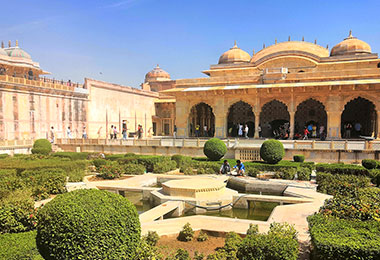
Amber Fort
In the morning, you will be guided to ascend the Amber Fort on foot or by jeep (with additional charge on site). The Amber Fort was beautifully decorated with countless glass walls sparkling in the sun. Next, we will have a photo stop at the Jal Mahal, which sits serenely in the middle of the Man Sagar Lake. It has four floors under the water and looks like it’s floating on the lake.
Later, we will tour the Maharaja City Palace, which features Indian and Islamic culture. Nowadays, it is not only a historical site, but also a museum with a collection of costumes, weapons and works of art that bear witness to India's long history. Afterwards, the guide will lead you to the Jantar Mantar, India’s largest ancient observatory and home to the world's largest sundial. At last, we will stop by the Hawa Mahal built of pink sandstone. With intricate latticework, small casements, and arched roofs, the facade of the five-story building, which resembles a giant honeycomb, is really photogenic.
Meals: Breakfast
Accommodation: Holiday Inn Jaipur City Centre



Later, we will tour the Maharaja City Palace, which features Indian and Islamic culture. Nowadays, it is not only a historical site, but also a museum with a collection of costumes, weapons and works of art that bear witness to India's long history. Afterwards, the guide will lead you to the Jantar Mantar, India’s largest ancient observatory and home to the world's largest sundial. At last, we will stop by the Hawa Mahal built of pink sandstone. With intricate latticework, small casements, and arched roofs, the facade of the five-story building, which resembles a giant honeycomb, is really photogenic.
Meals: Breakfast
Accommodation: Holiday Inn Jaipur City Centre
Day 5 Transfer to Agra & Visit Fatehpur Sikri En Route
After breakfast, we will head for Agra. On the way we will stop for a guided visit to the Fatehpur Sikri, an ancient town designated as a UNESCO World Heritage site. Its elaborate layout and interior design can rival even the Taj Mahal. Our driver will also take you to visit the Abhaneri Village famous for the Chand Baori, a beautifully designed stepwell that dates back over 1,000 years and is considered one of the largest in the world. Afterwards, we will continue our drive to Agra, and check into a local hotel for the night.
Meals: Breakfast
Accommodation: Holiday Inn Agra MG Road



Meals: Breakfast
Accommodation: Holiday Inn Agra MG Road
Day 6 Romantic Agra Tour with Taj Mahal
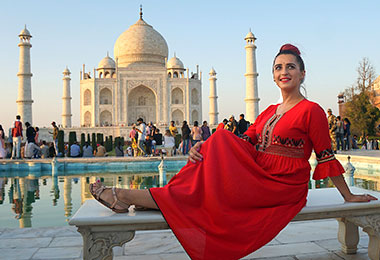
Taj Mahal
★ Watch Sunrise at Taj Mahal:
The Taj Mahal is considered to be the most perfect gem of Indian Muslim art, one of the New Seven Wonders of the World, and a must-see for everyone who visits India. Don’t want a mediocre visit? Come with us and wake up early in the morning to see the sunrise over the Taj Mahal! The moment the golden sun hits the ivory dome, you will realize why the famous poet Rabindranath Tagore once praised the Taj Mahal as ‘a teardrop on the cheek of time’.
After visiting the Taj Mahal, we will return to the hotel for breakfast, and then head for the Agra Fort. Here the guide will lead you to see hundreds of palaces, halls, towers and mosques in this grand fort. In the afternoon, we will visit the Tomb of Itimad-Ud-Daulah (Baby Taj), which is said to have inspired the design of the marvelous Taj Mahal. Although the architecture of the Baby Taj is not as large as that of the Taj Mahal, it pioneered a new style of Mughal mausoleum with more elaborate carvings and marble lattice designs. Finally, our guide will accompany you to visit the Mehtab Bagh, a peaceful garden with a beautiful view of the Taj Mahal from a distance.
Itimad-Ud-Daulah - Baby Taj or Mother Taj?
A Persian nobleman named Mirza Ghiyas Beg, who made significant contributions to the Mughal Empire, earned him the title of Itimad-Ud-Daulah. His daughter married the son of Akbar the Great. After his and his wife's death in 1622, their daughter Nur Jahan, who was already the queen at the time, spent 6 years to build the Tomb of Itimad-ud-Daulah in memory of her parents.
The next King Shah Jahan built the Taj Mahal in memory of his wife in 1631-1653, which was partly inspired by the Tomb of Itimad-ud-Daulah. So, it predates the Taj Mahal and is only called Baby Taj due to its relatively smaller size, maybe Mini Taj is more appropriate here. And in terms of status, it is truly the Mother Taj.
Meals: Breakfast
Accommodation: Holiday Inn Agra MG Road



The Taj Mahal is considered to be the most perfect gem of Indian Muslim art, one of the New Seven Wonders of the World, and a must-see for everyone who visits India. Don’t want a mediocre visit? Come with us and wake up early in the morning to see the sunrise over the Taj Mahal! The moment the golden sun hits the ivory dome, you will realize why the famous poet Rabindranath Tagore once praised the Taj Mahal as ‘a teardrop on the cheek of time’.
After visiting the Taj Mahal, we will return to the hotel for breakfast, and then head for the Agra Fort. Here the guide will lead you to see hundreds of palaces, halls, towers and mosques in this grand fort. In the afternoon, we will visit the Tomb of Itimad-Ud-Daulah (Baby Taj), which is said to have inspired the design of the marvelous Taj Mahal. Although the architecture of the Baby Taj is not as large as that of the Taj Mahal, it pioneered a new style of Mughal mausoleum with more elaborate carvings and marble lattice designs. Finally, our guide will accompany you to visit the Mehtab Bagh, a peaceful garden with a beautiful view of the Taj Mahal from a distance.
Itimad-Ud-Daulah - Baby Taj or Mother Taj?
A Persian nobleman named Mirza Ghiyas Beg, who made significant contributions to the Mughal Empire, earned him the title of Itimad-Ud-Daulah. His daughter married the son of Akbar the Great. After his and his wife's death in 1622, their daughter Nur Jahan, who was already the queen at the time, spent 6 years to build the Tomb of Itimad-ud-Daulah in memory of her parents.
The next King Shah Jahan built the Taj Mahal in memory of his wife in 1631-1653, which was partly inspired by the Tomb of Itimad-ud-Daulah. So, it predates the Taj Mahal and is only called Baby Taj due to its relatively smaller size, maybe Mini Taj is more appropriate here. And in terms of status, it is truly the Mother Taj.
Meals: Breakfast
Accommodation: Holiday Inn Agra MG Road
Day 7 Fly to Kathmandu with a Connection in Delhi
After breakfast, our driver will escort you to the Agra Airport for a flight to Delhi. Upon arrival in Delhi, you will transfer to a flight we have booked for you to Kathmandu, the capital of Nepal. Once you arrive, you will be met by our representative in Kathmandu and transferred to a hotel we have carefully selected for you. The rest of the day will be free to for you to wander around the city.
► Eight Things to Do When Traveling in Katmandu
1. It is said that walking around the Bouddhanath Stupa three times can eliminate greed, anger and ignorance.
2. Feel life and death at the Pashupatinath Temple. 86.2% of Nepalese people faith in Hinduism. They believe that burning their bodies and scattering ashes into their holy river after death can free their souls from their sins and get a better beginning in the next life through reincarnation. You can watch the whole process clearly at the other side of the river.
3. To see Kumari at Durbar Square. Kumari is known as the living goddess. Girls aged 5-7 are strictly selected to be a living goddess. During her years as a goddess, she lives in the temple and her feet cannot touch the ground. Even more, she should remain serious and silent in front of people, and can only be carried out of the temple 13 times a year for major events. A new Kumuri will replace her after her menarche.
4. Overlooking Kathmandu for a panoramic view from mountain Swoyambhunath.
5. Take a stroll along the Thamel Street, where full of small shops and restaurants, always crowded with the locals and tourists.
6. Try authentic Nepalese cuisine, such as Dal Bhat, Momo - a kind of dumpling and Thali.
7. Try local beer made from water of Himalayan, Gorkha Strong can be a choice at the costs of 550 rupees per bottle.
8. If interested, you can rent or buy a local traditional dress, which will help you get special pictures in a happy mood.
Meals: Breakfast
Accommodation: Hotel Himalaya



► Eight Things to Do When Traveling in Katmandu
1. It is said that walking around the Bouddhanath Stupa three times can eliminate greed, anger and ignorance.
2. Feel life and death at the Pashupatinath Temple. 86.2% of Nepalese people faith in Hinduism. They believe that burning their bodies and scattering ashes into their holy river after death can free their souls from their sins and get a better beginning in the next life through reincarnation. You can watch the whole process clearly at the other side of the river.
3. To see Kumari at Durbar Square. Kumari is known as the living goddess. Girls aged 5-7 are strictly selected to be a living goddess. During her years as a goddess, she lives in the temple and her feet cannot touch the ground. Even more, she should remain serious and silent in front of people, and can only be carried out of the temple 13 times a year for major events. A new Kumuri will replace her after her menarche.
4. Overlooking Kathmandu for a panoramic view from mountain Swoyambhunath.
5. Take a stroll along the Thamel Street, where full of small shops and restaurants, always crowded with the locals and tourists.
6. Try authentic Nepalese cuisine, such as Dal Bhat, Momo - a kind of dumpling and Thali.
7. Try local beer made from water of Himalayan, Gorkha Strong can be a choice at the costs of 550 rupees per bottle.
8. If interested, you can rent or buy a local traditional dress, which will help you get special pictures in a happy mood.
Meals: Breakfast
Accommodation: Hotel Himalaya
Day 8 Nepal Highlights in Kathmandu and Bhaktapur
After breakfast, our guide will lead you to visit the Pashupatinath Temple, which is the oldest Hindu temple in Kathmandu. Next, we will move forward to Bhaktapur, which is located around 14 km (9 mi) east of Kathmandu and is known as the ‘City of Devotees’. We will stroll on the Bhaktapur Durbar Square, once the royal palace and now a UNESCO World Heritage site, to visit the highest pagoda in Nepal – the Nyatapola Temple, as well as the 590-year-old Dattatreya Temple. After touring the square, the guide will take you up to a hilltop to visit the Changu Narayan Temple, which is considered the oldest Hindu temple in Nepal.
Meals: Breakfast
Accommodation: Hotel Himalaya



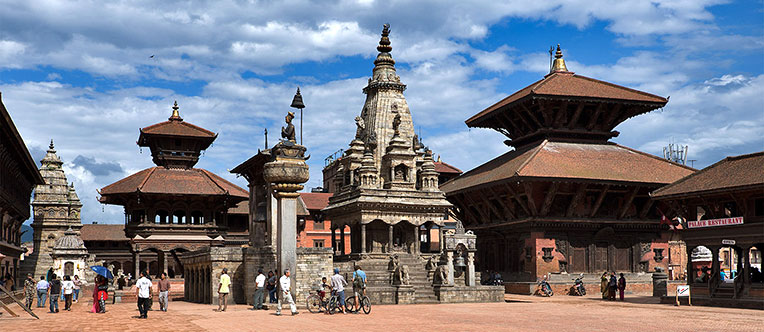
Meals: Breakfast
Accommodation: Hotel Himalaya

Bhaktapur Durbar Square
Day 9 Kathmandu Sightseeing & Extension to Patan
In the morning, we will set out for the Swoyambhunath Stupa and Katmandu Durbar Square. There our guide will accompany you to see a wealth of historical monuments from the 16th to the 19th centuries, including 50 temples and palaces. The highlights include the Kumari Temple, a three-story Buddhist temple famous for the ‘living Goddess Kumari’. Here we will also enjoy the exterior designs of two Hindu temples including the Taleju Temple in the shape of yantra (a diagram from the Indian religions), and the Kal Bhairav which features a large sculpture dedicated to Kal Bhairav.
In the afternoon, we will continue the visit to the Bouddhanath Stupa, one of the biggest spherical stupas in the world. We will finish the day at the Patan Durbar Square, a UNESCO World Heritage site, which still holds old residential houses and temples. Here, you will be guided to visit the 12th-century Golden Temple, a gilded Buddhist temple with intricate carvings and lion sculptures.
Precautions when visiting the Monkey Temple
1. Money Temple is actually the Swoyambhunath Stupa. The car can only park halfway up the mountain and then you need about 8 minutes to climb up the stairs on both sides.
2. Do not bring snacks or drinks to prevent grabbing from monkeys. And the road up the mountain is full of vendors, beggars and monkeys. Please be careful.
3. Be sure to reach the mountaintop, where you can see the panoramic view of Kathmandu, and the best time is early morning for sunrise or sunset in late afternoon.
Meals: Breakfast
Accommodation: Hotel Himalaya



In the afternoon, we will continue the visit to the Bouddhanath Stupa, one of the biggest spherical stupas in the world. We will finish the day at the Patan Durbar Square, a UNESCO World Heritage site, which still holds old residential houses and temples. Here, you will be guided to visit the 12th-century Golden Temple, a gilded Buddhist temple with intricate carvings and lion sculptures.
Precautions when visiting the Monkey Temple
1. Money Temple is actually the Swoyambhunath Stupa. The car can only park halfway up the mountain and then you need about 8 minutes to climb up the stairs on both sides.
2. Do not bring snacks or drinks to prevent grabbing from monkeys. And the road up the mountain is full of vendors, beggars and monkeys. Please be careful.
3. Be sure to reach the mountaintop, where you can see the panoramic view of Kathmandu, and the best time is early morning for sunrise or sunset in late afternoon.
Meals: Breakfast
Accommodation: Hotel Himalaya
Day 10 Kathmandu Airport See-off
On the last day, our guide and the driver will escort you to the Kathmandu Airport for your departure flight. Wish you a safe and pleasant trip home! Please feel free to contact us if you would like an extensional trip to other Asian countries or destinations around the world.
Meals: Breakfast
Meals: Breakfast
Expand All
Collapse All
This trip can be customized to meet your individual needs!
Tour Prices
2025 & 2026 Specials: 10% off - Book before Apr 30, 2025
| Travelers | 2-3 travelers | 4-5 travelers |
|---|---|---|
| Jan-Mar, Oct-Dec | USD2099 USD1889 | USD1879 USD1691 |
| Apr-Sep | USD1999 USD1799 | USD1779 USD1601 |
- Prices are per person on twin sharing.
- The prices in red reflect 10% discount.
- If you are a group of 6 people or more, we will offer a more favorable price by your group size.
Price Includes
- Economy class airfares of Agra/ Delhi/ Kathmandu
- Accommodation with daily breakfast at hotels
- Service of English speaking guides per the itinerary
- Transfers in private A/C vehicle
- Entrance fees for sights mentioned in the itinerary
- 2 bottles of water per person per day & wet tissues in vehicle
- All government applicable taxes and service charges
Price Excludes
- International flight into Delhi and out of Kathmandu
- Lunches and dinners, but advice freely available
- Personal expenses (such as laundry, telephone, drinks, etc.)
- Tips for guides and drivers
- Personal travel insurance
- India and Nepal visa fee
Itineraries you may also like:


